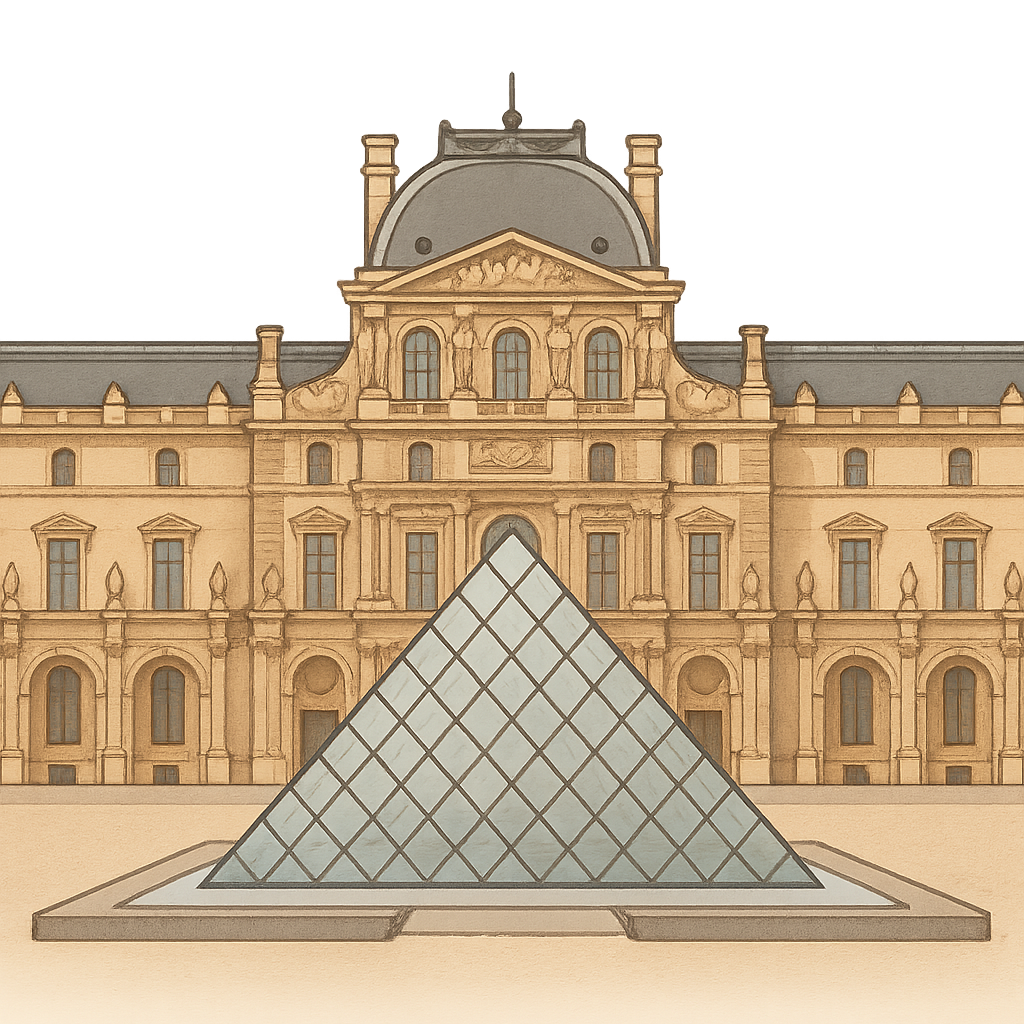The Keeper of Stories
Sunlight dances across a giant pyramid made of glass, sending shimmering patterns across a courtyard paved with ancient stones. I hear the murmur of a hundred different languages as people from every corner of the world walk through my gates, their footsteps echoing on floors that have felt the weight of history for more than eight hundred years. My long stone arms stretch gracefully along the River Seine, right in the vibrant heart of Paris, France. I have been a witness to kings and revolutions, to artists dreaming and soldiers marching. I hold within me the whispers of the past and the creative sparks of humanity. I am the Louvre.
My story did not begin with art and beauty, but with stone and strength. I was born from a need for protection. Imagine a time long ago, around the year 1190, when Paris was a much smaller city, vulnerable to attack. A powerful king, Philip II, knew he had to defend his capital. He commanded his builders to raise me from the earth, not as a palace, but as a mighty fortress. My first walls were thick and imposing, surrounded by a deep, watery moat to keep enemies at bay. At my center stood a massive tower, the Grosse Tour, a formidable keep where the royal treasure was stored and important prisoners were held. My purpose was clear and serious: I was the guardian of Paris, my stone heart dedicated to the safety of the kingdom. I stood watchful and unyielding against the dangers of the medieval world.
Centuries passed, and the world changed around me. The need for a military fortress in the center of Paris faded, and a new vision for my future began to take shape. In the 16th century, a king with a deep love for art and culture, Francis I, decided I should no longer be a grim, gritty castle. He dreamed of transforming me into a magnificent royal palace, a home fit for the kings of France. He invited brilliant architects and artists to reshape me, drawing inspiration from the Italian Renaissance and even from the notebooks of the great Leonardo da Vinci, whom he had brought to France. Over the next two hundred years, king after king added to my splendor. New wings were built, grand galleries were carved out, and my halls began to fill with breathtaking paintings and sculptures. The most famous of these rulers, King Louis XIV, known as the Sun King, lavished attention on me, making me grander than ever. But in 1682, he moved his entire court to a new, even more extravagant palace at Versailles. I was left behind, quiet and empty of royal life, but I was not forgotten. I had become a vast, silent keeper of the kingdom's priceless art collection.
My greatest transformation, the one that defined my soul, came from a storm of change that swept across France. The French Revolution began in 1789, and with it came a powerful and revolutionary idea: that the treasures I held belonged not to a king, but to the people. The art, the history, and the knowledge locked within my walls were the heritage of all citizens, and they should be able to see it, learn from it, and be inspired by it. On August 10, 1793, a momentous decision was made, and my doors were officially opened to the public as a museum for the first time. The excitement was immense. I was no longer a private royal residence but a shared public space for discovery and wonder. A few years later, a leader named Napoleon Bonaparte marched across Europe, and as he did, he gathered countless works of art, sending them back to Paris to be displayed within my galleries. My collection grew enormously, making me a true treasure chest for the entire world.
My journey continues even today, as I strive to connect the past with the present. You can see this clearly when you visit my main courtyard. In 1989, a bold new entrance was unveiled—a stunning glass and steel pyramid designed by the architect I. M. Pei. At first, some people were shocked to see such a modern structure in the midst of my historic stone facades. But the pyramid became my modern heart, a symbol of how I am always evolving while honoring my deep history. It is a doorway that welcomes millions of people each year to explore the wonders I protect. Inside my halls, you can stand before the mysterious smile of the Mona Lisa, gaze at the timeless grace of the Venus de Milo, and travel through thousands of years of human creativity. I am more than a building. I am a place where stories from every age and every culture live together, continuing to inspire the artists, thinkers, and dreamers of today and tomorrow.
Reading Comprehension Questions
Click to see answer
